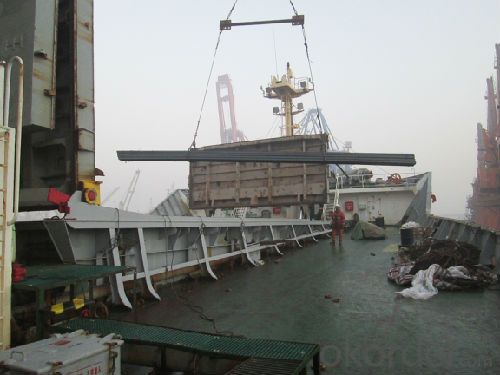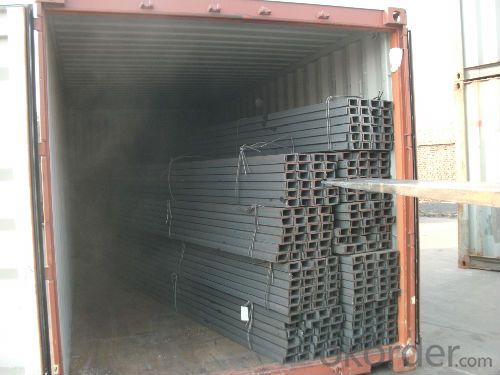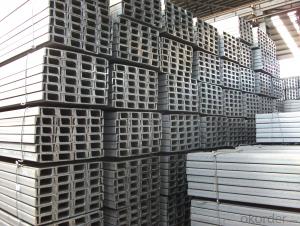Alloy Low Carbon Steel U Channel UPN EN Standard
- Loading Port:
- Tianjin
- Payment Terms:
- TT or LC
- Min Order Qty:
- 200 m.t.
- Supply Capability:
- 5000 m.t./month
OKorder Service Pledge
OKorder Financial Service
You Might Also Like
OKorder is offering Alloy Low Carbon Steel U Channel UPN at great prices with worldwide shipping. Our supplier is a world-class manufacturer of steel, with our products utilized the world over. OKorder annually supplies products to African, South American and Asian markets. We provide quotations within 24 hours of receiving an inquiry and guarantee competitive prices.
Product Applications:
Alloy Low Carbon Steel U Channel UPN are ideal for structural applications and are widely used in the construction of buildings and bridges, and the manufacturing, petrochemical, and transportation industries.
Product Advantages:
OKorder's Alloy Low Carbon Steel U Channel UPN are durable, strong, and wide variety of sizes.
Main Product Features:
· Premium quality
· Prompt delivery & seaworthy packing (30 days after receiving deposit)
· Can be recycled and reused
· Mill test certification
· Professional Service
· Competitive pricing
Product Specifications:
Manufacture: Hot rolled
Grade: Q195 – 235
Certificates: ISO, SGS, BV, CIQ
Length: 6m – 12m, as per customer request
Packaging: Export packing, nude packing, bundled
UPN U CHANNEL | Standard
h | Sectional
b | Dimension
s |
T | Mass:
Kg/m |
(mm) | (mm) | (mm) | (mm) | ||
80x45 | 80 | 45 | 6.0 | 8.0 | 8.64 |
100X50 | 100 | 50 | 6.0 | 8.5 | 10.6 |
120x55 | 120 | 55 | 7.0 | 9.0 | 13.4 |
140x60 | 140 | 50 | 7.0 | 10.0 | 16.0 |
160x65 | 160 | 65 | 7.5 | 10.0 | 18.8 |
180x70 | 180 | 70 | 8.0 | 11.0 | 22.0 |
FAQ:
Q1: Why buy Materials & Equipment from OKorder.com?
A1: All products offered byOKorder.com are carefully selected from China's most reliable manufacturing enterprises. Through its ISO certifications, OKorder.com adheres to the highest standards and a commitment to supply chain safety and customer satisfaction.
Q2: How do we guarantee the quality of our products?
A2: We have established an advanced quality management system which conducts strict quality tests at every step, from raw materials to the final product. At the same time, we provide extensive follow-up service assurances as required.
Q3: How soon can we receive the product after purchase?
A3: Within three days of placing an order, we will arrange production. The normal sizes with the normal grade can be produced within one month. The specific shipping date is dependent upon international and government factors, the delivery to international main port about 45-60days.
Images:


- Q:Can steel channels be used for supporting heavy machinery?
- Yes, steel channels can be used for supporting heavy machinery. Steel channels are known for their strength and durability, making them suitable for bearing heavy loads. They provide a stable and rigid support structure, ensuring the safe and secure installation of heavy machinery.
- Q:What's the width of the 22 channel wing?
- Standard 22# channel steel has 77 and 79, two widths.
- Q:How to input the sign of channel steel in Excel
- Channel steel is used for construction and mechanical use of carbon structural steel, is a complex cross-section of steel, its cross section shape is groove shape, mainly used for building structure, curtain wall engineering, mechanical equipment and vehicle manufacturing;
- Q:What are the common applications of steel channels?
- Steel channels, also known as C-channels or U-channels, are versatile structural components that find numerous applications across various industries. Here are some common applications of steel channels: 1. Construction industry: Steel channels are extensively used in the construction industry for structural support and framing purposes. They provide strength and stability to buildings, bridges, and other structures. Steel channels are often used as beams, columns, and purlins to distribute weight and resist deformation. 2. Building facades: Steel channels are utilized in building facades to create decorative and functional elements. They can be used as curtain wall frames, window frames, and cladding supports. Steel channels provide durability, weather resistance, and a sleek aesthetic to the building exteriors. 3. Manufacturing and industrial applications: Steel channels are widely employed in manufacturing and industrial settings for various equipment and machinery. They are used as support structures for conveyor systems, racks, shelves, and platforms. Steel channels offer high load-bearing capacity and can withstand heavy loads, making them suitable for industrial applications. 4. Electrical installations: Steel channels are commonly used in electrical installations to provide support and protection for electrical cables and wiring. They are used as cable trays, raceways, and support systems for electrical equipment. Steel channels ensure organized and secure routing of electrical cables, preventing damage and reducing the risk of electrical hazards. 5. Automotive industry: Steel channels are utilized in the automotive industry for various applications. They are used in the construction of vehicle frames, chassis, and suspension systems. Steel channels provide strength, rigidity, and impact resistance, ensuring the structural integrity and safety of automobiles. 6. Infrastructure projects: Steel channels are crucial components in infrastructure projects such as bridges, highways, and railways. They are used in the construction of bridge beams, guardrails, and noise barriers. Steel channels offer excellent load-bearing capabilities and durability, making them suitable for heavy-duty infrastructure applications. 7. Furniture and interior design: Steel channels are used in the manufacturing of furniture and interior design elements. They can be incorporated into tables, chairs, shelves, and cabinets to provide structural support and enhance aesthetics. Steel channels offer a modern and industrial look, making them a popular choice in contemporary furniture and interior design. Overall, steel channels are versatile components that find extensive applications in construction, manufacturing, electrical installations, automotive, infrastructure, and furniture industries. Their strength, durability, and adaptability make them an essential choice in various structural and functional applications.
- Q:How do steel channels contribute to natural ventilation?
- Steel channels can contribute to natural ventilation in several ways. Firstly, steel channels can be used to create air vents or openings in buildings. These vents allow fresh air to enter the building and circulate, helping to remove stale air and improve indoor air quality. The channels can be strategically placed to maximize airflow and create a natural flow of air. Additionally, steel channels can be used to create louvers or slats in windows or facades. These louvers allow for adjustable ventilation, allowing occupants to control the amount of air entering the building according to their preference. By adjusting the position of the louvers, the flow of air can be directed towards specific areas or rooms, providing targeted ventilation where it is needed most. Moreover, steel channels can be used to create chimneys or exhaust vents. These structures help to expel hot air, smoke, and other pollutants from the building, promoting a healthier and more comfortable indoor environment. By creating a vertical airflow, the channels help to remove heat build-up and improve air circulation, which is especially beneficial in spaces with high humidity or where odors and contaminants may be present. Overall, steel channels play a crucial role in natural ventilation by providing openings, louvers, and exhaust vents that facilitate the movement of air. By harnessing natural forces such as wind and thermal buoyancy, these channels help to create a sustainable and energy-efficient ventilation system that improves the comfort and well-being of building occupants.
- Q:Channel
- In use, it requires better welding, riveting performance and comprehensive mechanical properties. The raw material steel billet for channel steel is carbon or low alloy steel billets with a carbon content of not more than 0.25%. The finished channel steel is delivered by hot forming, normalizing or hot rolling. The specifications are expressed in millimeters of height (H) * leg width (b) * waist thickness (d), such as 100*48*5.3, which means waist height is 100 mm, leg width is 48 mm, waist thickness is 5.3 mm channel, or 10# channel steel. The same height of the channel, if there are several different leg width and waist thickness, also need to add a, B, C on the right side of the model to distinguish, such as 25#a, 25#b, 25#c and so on.
- Q:What is the square bevel washer used for channel steel?
- The inclination of the channel steel and the angle of the square bevel washer coincide with the standard.
- Q:What are the factors to consider when determining the appropriate height of a steel channel?
- When determining the appropriate height of a steel channel, several factors need to be considered. These factors include the load-bearing capacity required, the span or distance between supports, the type and weight of the load being supported, the material properties of the steel channel, and the desired deflection or bending of the channel under load. Firstly, it is crucial to assess the load-bearing capacity required for the steel channel. This involves considering the maximum weight the channel needs to support without buckling or failing. The load-bearing capacity depends on the application and the anticipated loads that will be applied to the channel. The span or distance between supports is another critical factor. Longer spans generally require taller steel channels to provide adequate support and minimize deflection. Shorter spans, on the other hand, may allow for smaller and less rigid channels. The type and weight of the load being supported are also important considerations. Different loads exert different forces on the channel, such as point loads or uniformly distributed loads. Heavier loads will require taller and stronger steel channels to ensure structural integrity. The material properties of the steel channel play a role in determining the appropriate height. Different steel alloys have different strength and stiffness properties. The choice of alloy will depend on the load requirements and the structural design. Lastly, the desired deflection or bending of the channel under load needs to be considered. Deflection refers to the amount of flex or bending that the channel experiences when loaded. In some applications, minimal deflection is desired, while in others, some deflection may be acceptable. In conclusion, when determining the appropriate height of a steel channel, it is vital to consider factors such as load-bearing capacity, span, type and weight of the load, material properties, and desired deflection. A thorough analysis of these factors will help ensure the steel channel is appropriately sized and capable of meeting the intended structural requirements.
- Q:According to the standard, indoor hanging stone 3 meters high, whether to add channel?
- The most necessary to use the channel skeleton, hanging directly on the wall is not safe
- Q:How are steel channels protected against rust during construction?
- Steel channels are typically protected against rust during construction by applying a corrosion-resistant coating such as galvanization or paint. These protective coatings act as a barrier, preventing moisture and oxygen from reaching the steel surface, thus inhibiting the formation of rust. Additionally, proper storage and handling practices are followed to minimize exposure to moisture and ensure the integrity of the protective coatings.
1. Manufacturer Overview |
|
|---|---|
| Location | |
| Year Established | |
| Annual Output Value | |
| Main Markets | |
| Company Certifications | |
2. Manufacturer Certificates |
|
|---|---|
| a) Certification Name | |
| Range | |
| Reference | |
| Validity Period | |
3. Manufacturer Capability |
|
|---|---|
| a)Trade Capacity | |
| Nearest Port | |
| Export Percentage | |
| No.of Employees in Trade Department | |
| Language Spoken: | |
| b)Factory Information | |
| Factory Size: | |
| No. of Production Lines | |
| Contract Manufacturing | |
| Product Price Range | |
Send your message to us
Alloy Low Carbon Steel U Channel UPN EN Standard
- Loading Port:
- Tianjin
- Payment Terms:
- TT or LC
- Min Order Qty:
- 200 m.t.
- Supply Capability:
- 5000 m.t./month
OKorder Service Pledge
OKorder Financial Service
Similar products
New products
Hot products
Related keywords





























